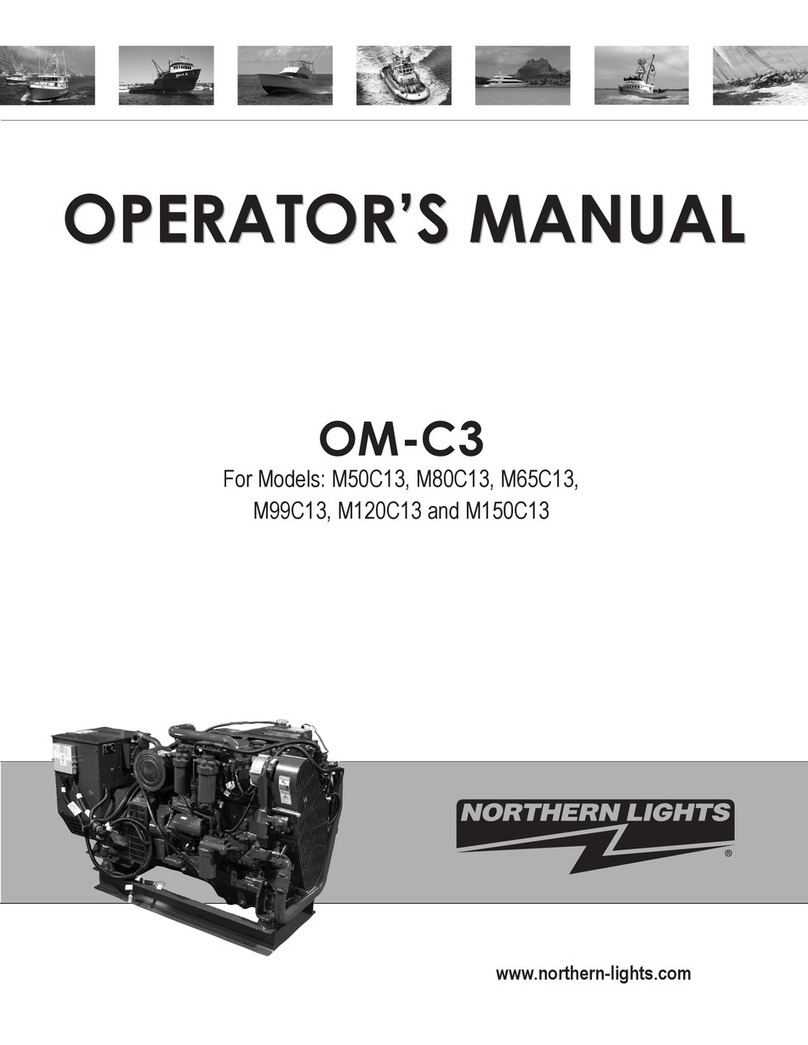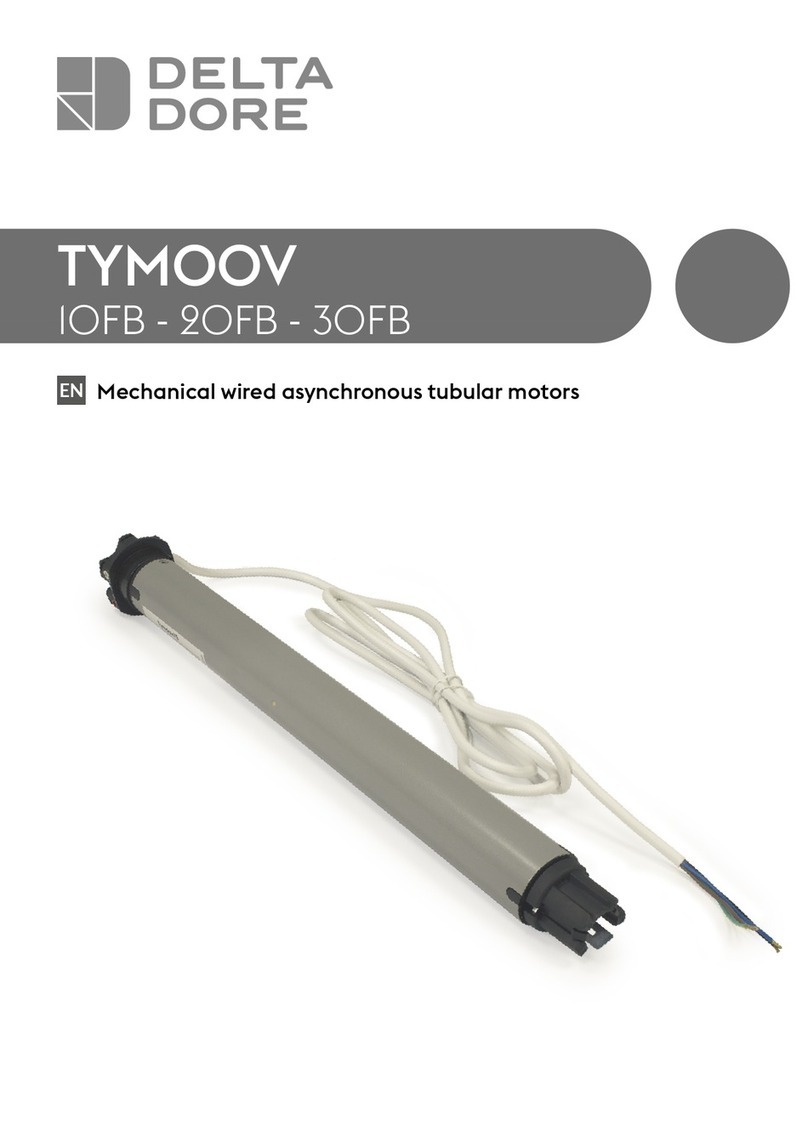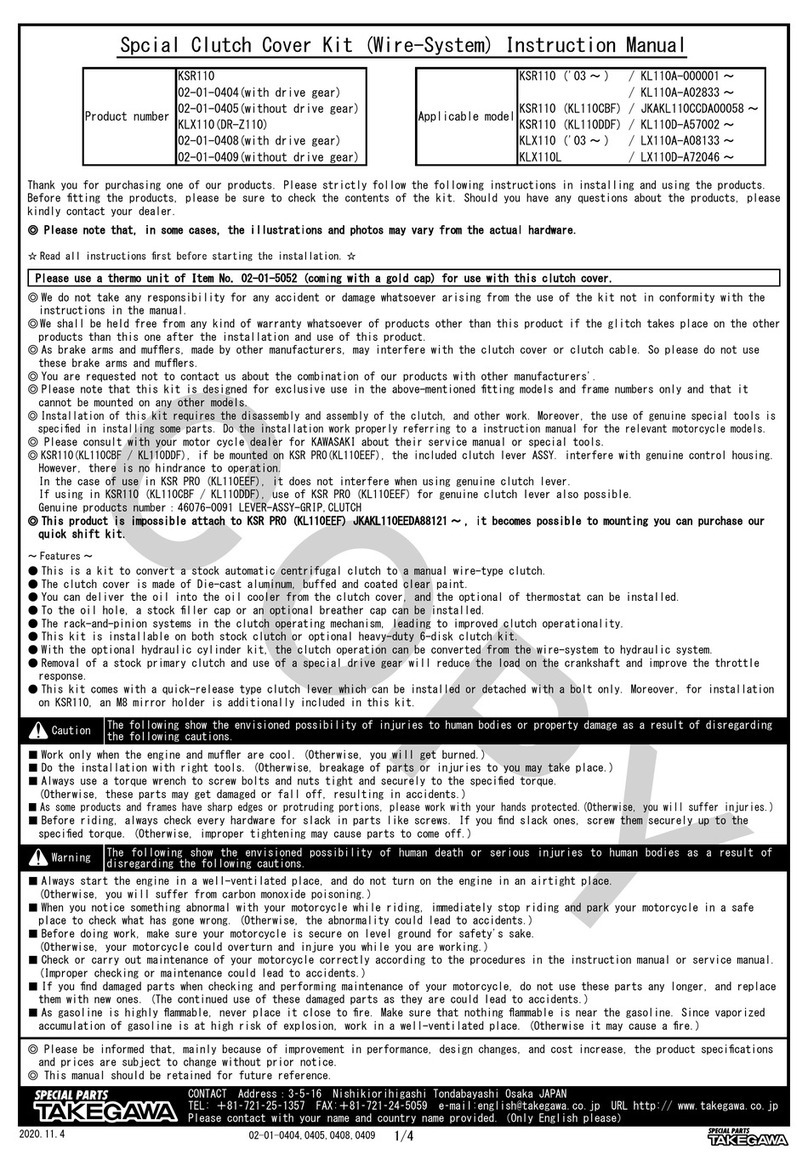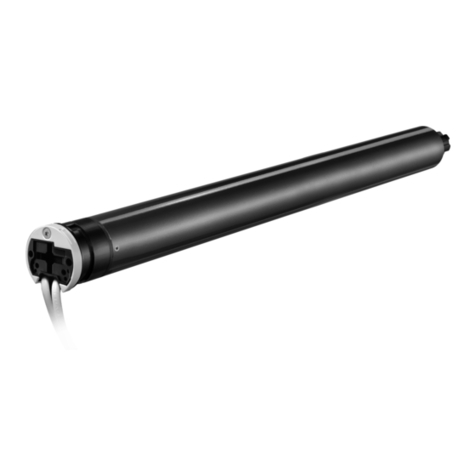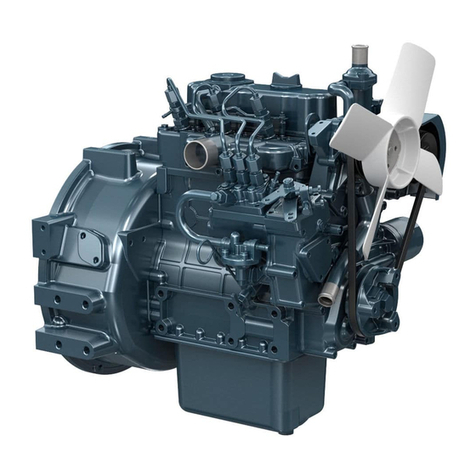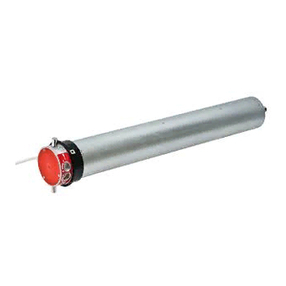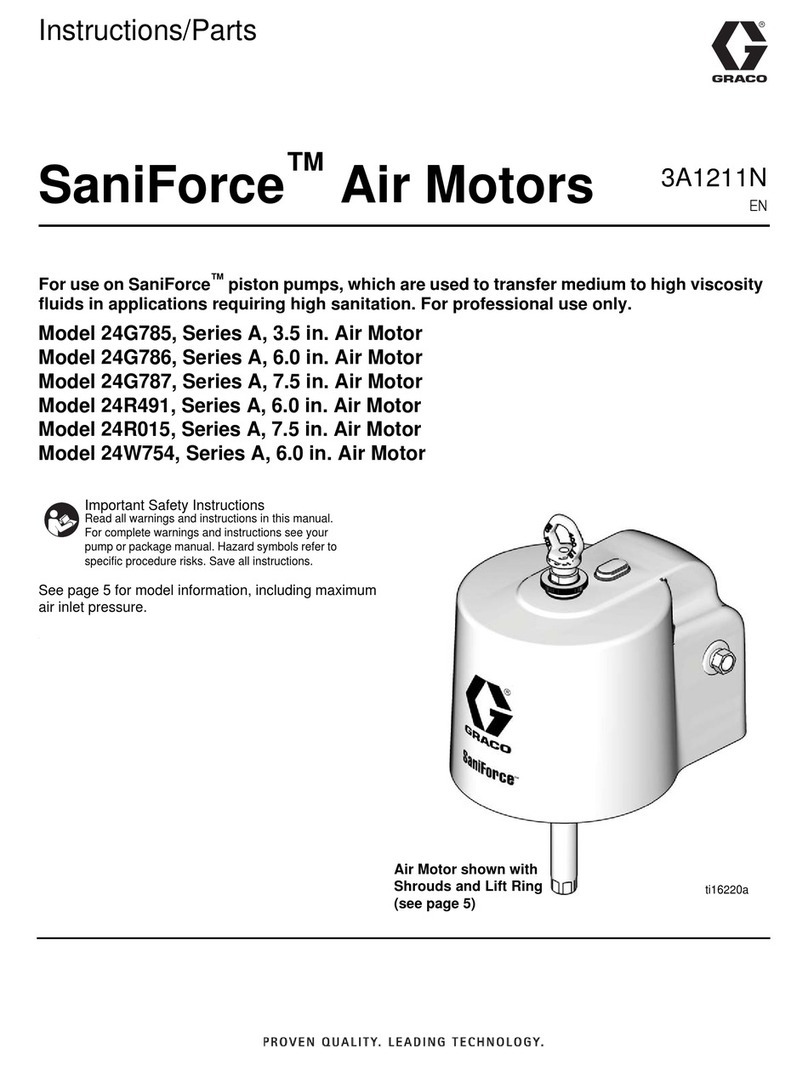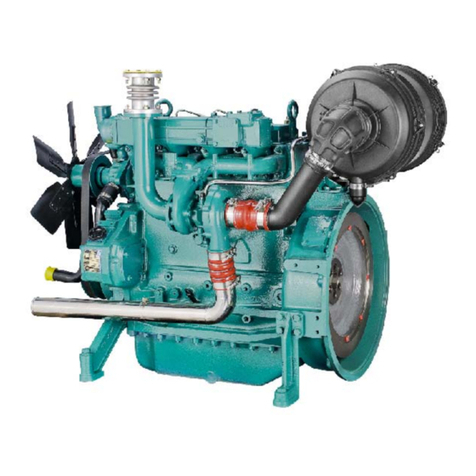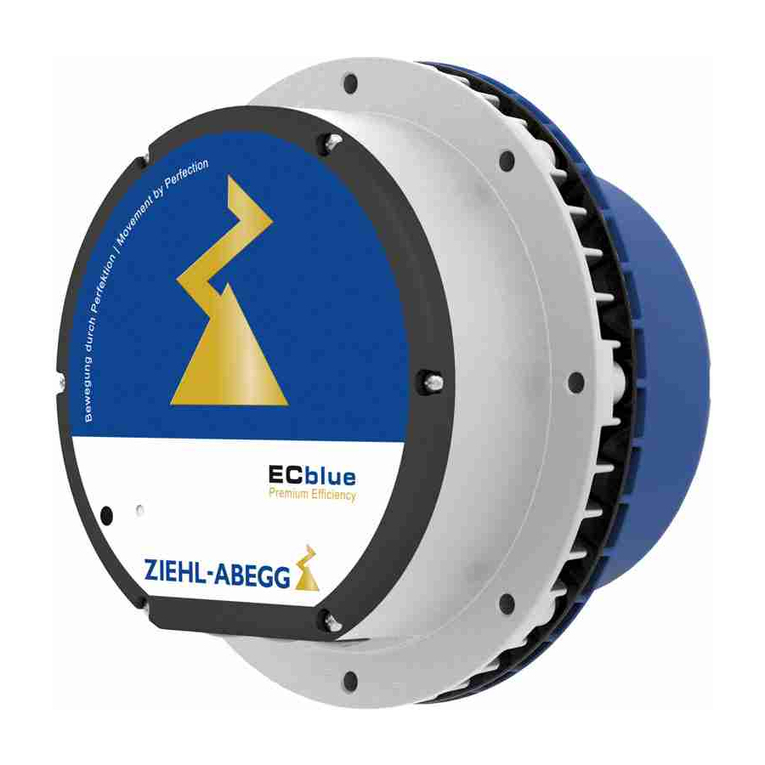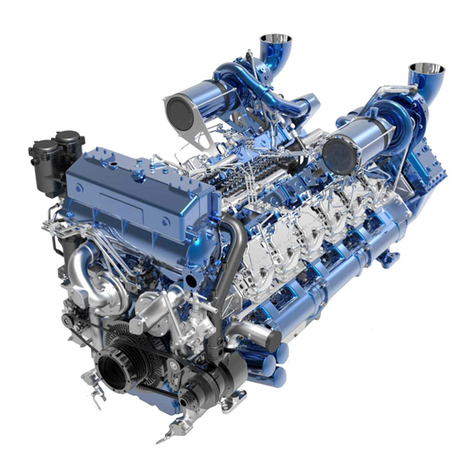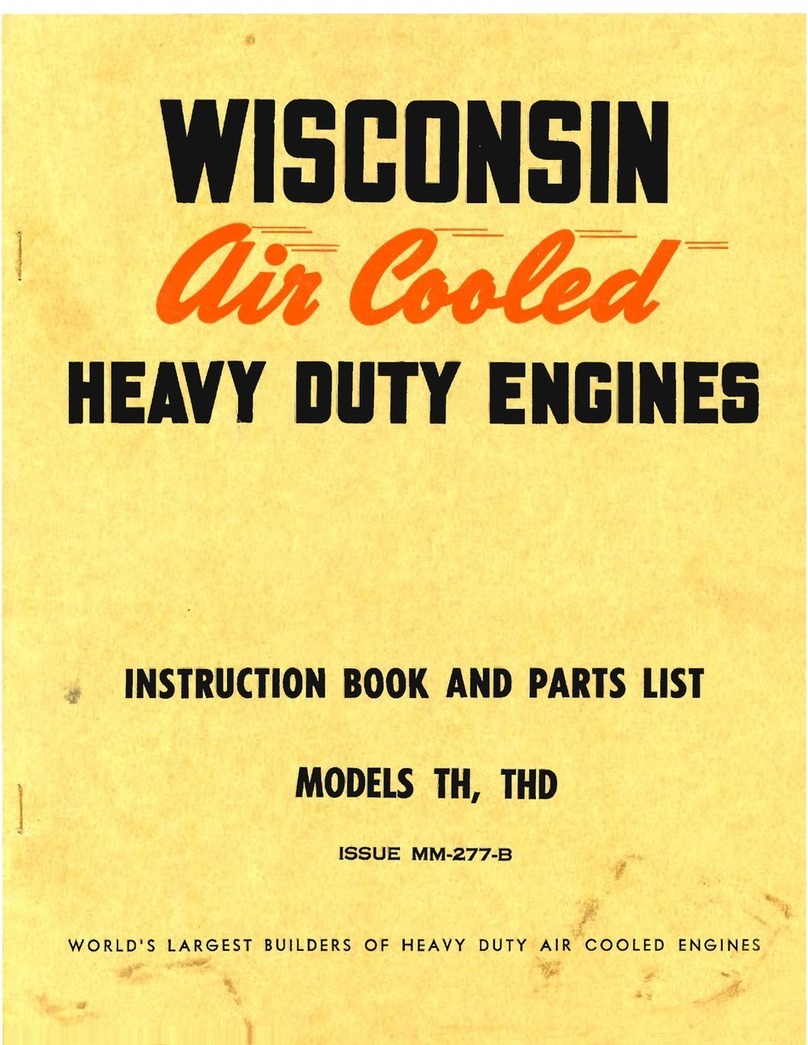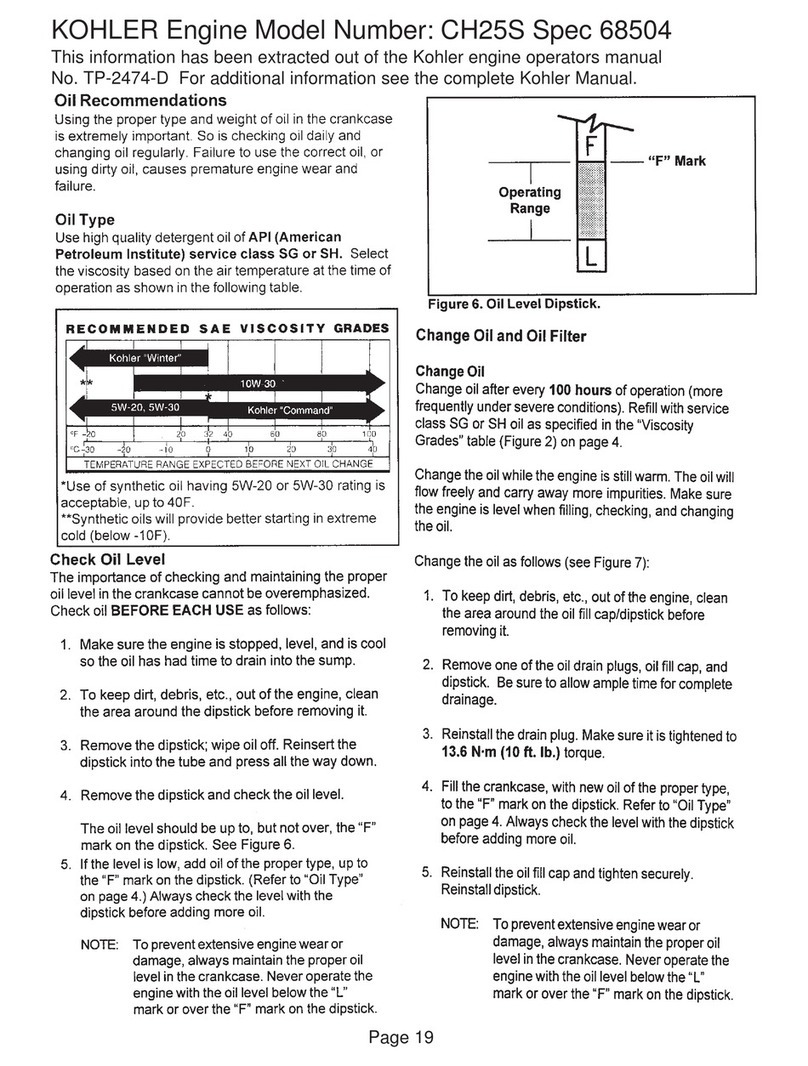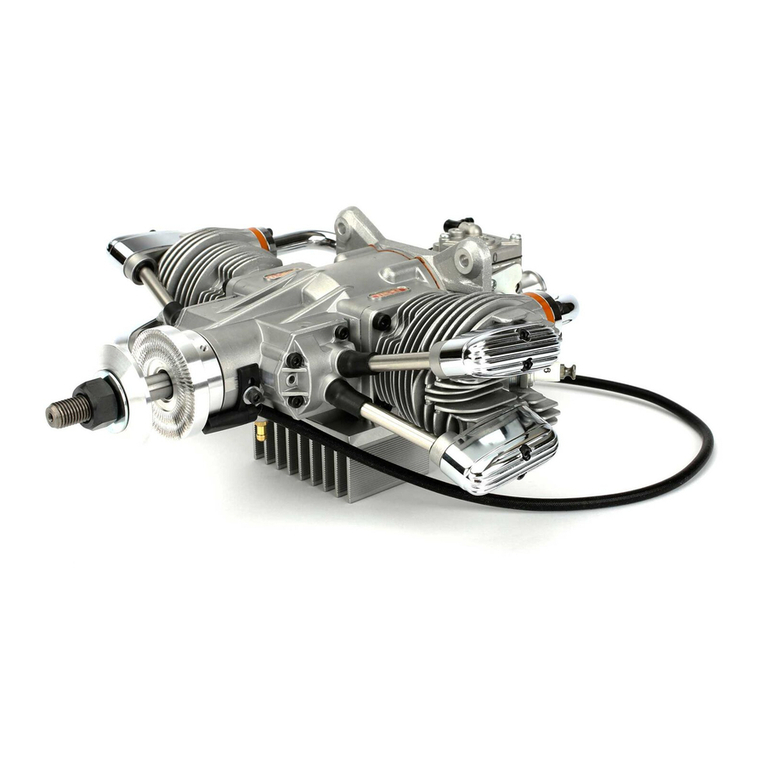Northern Lights M844W3 User manual

OPERATOR’S MANUAL
OPERATOR’S MANUAL
OM844W3
For Models: M844W3, M844DW3, M844DW3G
M844LW3, M844LW3G, M20CRW3
www.northern-lights.com

Breathing Diesel engine exhaust and some of its constituents
are known to the State of California to cause cancer, birth
defects, and other reproductive harm.
* Always start and operate the engine in a well-ventilated area.
* If in an enclosed area, vent the exhaust to the outside.
* Do not modify or tamper with the exhaust system.
* Do not idle the engine except as necessary.
For more information, go to www.P65warnings.ca.gov/diesel.
— CALIFORNIA —
Proposition 65 Warning:
Northern Lights
4420 14th Avenue NW
Seattle, WA 98107
Tel: (206) 789-3880
Fax: (206) 782-5455
Copyright ©2021 Northern Lights, Inc.
All rights reserved. Northern Lights™, and
the Northern Lights logo are trademarks of
Northern Lights, Inc.
Printed in U.S.A.
PART NO.: OM844W3 5/21

OM844W3 5/21
1
Read this operator's manual thoroughly before starting to operate your equipment.
This manual contains information you will need to run and service your new unit.
Proprietary Information
This publication is the property of Northern Lights, Inc.
It may not be reproduced in whole or in part without the written permission of Northern Lights, Inc.
© Northern Lights, Inc. All rights reserved. Litho U.S.A. Publication number OM844W3 5/21
OPERATOR'S MANUAL
for Models
M844W3, M844DW3, M844DW3G,
M844LW3, M844LW3G and M20CRW3
Table of Contents
INTRODUCTION .................................................... 2
Unit Identication................................................. 2
Model Numbers .................................................... 2
Serial Numbers ..................................................... 2
WARRANTY ........................................................... 3
SAFETY RULES...................................................3-7
LOCK OUT / TAG OUT PROCEDURES.......... 8
COMPONENT LOCATIONS
M844W3 Marine Generator
(Gem Series base frame) ............................. 9
M844W3 Marine Generator
(2011 base frame).................................... 10
M20CRW3 Commercial Generator .................... 11
CONTROL PANELS ...........................................12
OPERATING PROCEDURES
Break-in Period...................................................13
Before Starting....................................................13
Starting................................................................13
Operating ............................................................13
Stopping..............................................................13
Shutdowns and Alarms .......................................14
Spare Parts ..........................................................14
SERVICING SCHEDULE CHART ....................15
SERVICING
Lubrication - General..........................................16
Checking Oil.......................................................16
Oil Changes ........................................................16
Changing Oil Filter .............................................16
Air Cleaner..........................................................17
V-Belts ................................................................17
Valve Clearances.................................................18
Fuels - General....................................................19
Fuel Filters ..........................................................19
Injector Service............................................. 20-21
Injection Pump....................................................20
Cooling System - General...................................22
Water Quality......................................................22
Checking Coolant Level .....................................22
Cooling System Flushing....................................22
Heat Exchanger...................................................23
Raw Water Pump ................................................23
Exhaust Elbow ....................................................23
Generator Ends ...................................................23
Electrical System - General ................................23
Glow Plugs..........................................................23
Booster Batteries.................................................24
Battery Care ........................................................24
PTO Care ............................................................24
Winterizing / Out-of-Service ..............................24
TROUBLESHOOTING
Electrical .............................................................25
Engine .........................................................26 - 28
WIRING DIAGRAMS
AC Electrical ..............................................30 - 32
DC Electrical ..............................................33 - 41
Panel Diagrams...........................................42 - 45
APPENDIX (Non-Current Production Diagrams)
DC Electrical ..............................................46 - 49
Panel Diagrams...........................................50 - 54

OM844W3 5/21
2
Serial Numbers
Introduction
Unit Identication
Servicing of marine engines and generator sets presents
unique problems. In many cases boats cannot be moved
to a repair facility. Marine engines cannot be compared
to the servicing of automobiles, trucks or even farm
equipment. Failures often occur in remote areas far
from competent assistance. Marine engines are taxed
far more severely than auto or truck engines; therefore,
maintenance schedules must be adhered to more
strictly.
Failures can begin with minor problems that are
overlooked and become amplied when not corrected
during routine maintenance.
As operator, it is your obligation to learn about your
equipment and its proper maintenance. This is not a
comprehensive technical service manual. Nor will it
make the reader into an expert mechanic. Its aim is to
aid you in maintaining your unit properly.
MODELS INCLUDED
This manual covers the operating instructions for:
M844W3 marine generator sets,
M844DW3 marine generator sets,
Northern Lights marine diesel generator set with
an 844 engine and a PX-316K2 generator end.
US EPA TIer III.
M844W3
Your set has three serial numbers: 1an engine number stamped
on the block, 2a generator plate, and 3a generator set plate.
Use the serial number on the generator set plate when ordering parts
or in correspondence. The generator set plate is found on the service
side of the generator and resembles the drawing at left.
Generator set serial number plate.
Northern Lights marine diesel generator set with an
844L engine and a PX-320K2 generator end. US EPA
TIer III.
Northern Lights marine diesel generator set with
an 844L engine and a PX-320K2 generator end on a
Gem series base frame. US EPA TIer III.
M844DW3 M844LW3G
Northern Lights 20 kW (@ 60 Hz) commercial grade
marine generator set with a special generator end
.
US EPA TIer III.
M20CRW3
Model Numbers
Model numbers give the unit's application, block model, aspiration, and RPM:
=
==
=
M844LW3 marine generator sets,
M844LW3G marine generator sets, and
M20CRW3 commercial generator sets.
D, L, W, G, C, 3
M - Northern Lights marine
generator set
Model number of engine block
Bore Cylinders
84 mm 4
D- Series designation
L - Long stroke engine
W- Auxiliary Winding in Generator
End
G- GEM series base frame
3 - US EPA Tier III compliant
++
M 844
Northern Lights marine diesel generator set with
an 844L engine and a PX-320K2 generator end.
US EPA TIer III.
M844LW3 =
Updated 10-13-20

OM844W3 5/21
3
A warranty registration certicate is supplied with your set. It entitles the original purchaser of our equipment
to a warranty covering material or assembly faults. The extent of coverage is described in the Limited Warranty
Statement. We recommend that you study the statement carefully.
NOTE: If the warranty is to apply, the servicing instructions outlined in this manual must be followed. If further
information is needed, please contact an authorized dealer or the factory.
Safety Rules
Warranty
NOTICE: Accident reports show that careless use of engines causes a high percentage of accidents.
You can avoid accidents by observing these safety rules. Study these rules carefully and enforce them on the job.
IMPORTANT SAFETY INSTRUCTIONS.
Electromagnetic equipment, including generator sets
and their accessories, can cause bodily harm and
life threatening injuries when improperly installed,
operated or maintained. To prevent accidents be aware
of potential dangers and act safely.
READ AND FOLLOW ALL SAFETY
INSTRUCTIONS IN THIS MANUAL,
PRIOR TO THE INSTALLATION
OF ANY GENERATOR SET OR
ACCESSORY. KEEP THESE
INSTRUCTIONS FOR FUTURE
REFERENCE.
Recognize Safety Symbols and Instructions
In addition to the information found in this section, this
operator’s manual uses three dierent signal words to
outline potential dangers of a specic nature.
Follow All Safety Instructions
Carefully read and understand
all safety messages in this
manual and on your machine’s
safety signs. Keep signs in
good and clean condition.
Replace missing or damaged
signs. Be sure new equipment components and
repair parts include the current safety signs. For
replacement signs, proper placement of safety signs
or clarication on any safety issue, consult your
Northern Lights dealer or the factory.
There can be additional safety information contained
on parts and components from outside suppliers
that is not reproduced in this manual. Consult the
suppliers for additional safety information.
Learn how to operate the machine and how to use
the controls properly. Only trained personnel should
operate machines, or work on or around them.
Keep you machine in proper working condition.
UNAUTHORIZED MODIFICATIONS TO THE
MACHINERY MAY IMPAIR ITS FUNCTION
AND SAFETY PARAMETERS.
Prevent Bypass and Accidental
Starting
!
WARNING
Do not start engine by shorting across start terminal.
Engine will start if normal circuitry is bypassed,
creating a hazard by runaway machinery.
Start engine only from operator’s station.
!
DANGER
!
WARNING
!
CAUTION
DANGER indicates a hazardous situation which, if
not avoided, will result in death or serious injury.
WARNING indicates a hazardous situation which, if
not avoided, could result in death or serious injury.
CAUTION indicates a hazardous situation which,
if not avoided, could result in minor or moderate
injury.
DANGER: Northern Lights generator sets and /or any other diesel powered equipment provided by NLI is not provided
with spark arresting or explosion proof components, and therefore is not to be installed in the presence of combustible
gases having a ash point of 43.3 Degrees C (110 Degrees F) or lower, such as Gasoline, Propane, Natural Gas or other
similar fuel sources.
Updated 4-12-17

OM844W3 5/21
4
Safety Rules (Continued)
Wear Protective Clothing
!
WARNING
To prevent catching anything in moving machinery,
always wear close tting clothes and safety
equipment appropriate
to the job.
Prolonged exposure
to loud noise can
cause hearing loss or
impairment. Wear
suitable authorized
hearing protection,
such as earmus or plugs to protect against loud
noises.
Operating equipment requires the full attention of the
operator. Do not use radio or music headphones
while operating machinery.
Practice Safe Maintenance
!
CAUTION
Understand all service
procedures before starting work.
Keep area clean and dry. Never lubricate, service, or
adjust machine while it is in operation.
Keep hands, feet and clothing away from power-
driven equipment. When shutting down an engine,
disengage all power and operator controls. Allow
the engine to cool completely before beginning any
service work.
Securely support any machinery elements that must
be raised for service work with support or lifting
machinery specically intended for that purpose.
Keep all parts in good conditions and properly
installed. Fix damage immediately. Replace any
worn or broken parts. Remove any build up of
grease, oil or debris.
Disconnect battery ground cable (-) before making
any adjustments or service work.
Handle Fuel Safely - Avoid Flames
!
WARNING
Diesel is highly ammable and should be treated with
care at all times. Do do not refuel while smoking or
when near sparks or open ame.
ALWAYS STOP ENGINE BEFORE FUELING
MACHINE. Always ll
portable fuel tank outdoors.
Never fuel a hot engine.
Prevent accidental
discharge of starting uids
by storing all cans in a
cool, safe place, away
from sparks or open ame. Store with cap securely
on container. Never incinerate or puncture a fuel
container.
Prevent res by keeping machine clean of accumulated
trash, grease and debris. Always clean any spilled fuel
as swiftly as possible. Do not store oily rags, which
can ignite and burn spontaneously.
Be prepared if a re starts. Keep a rst aid kit and re
extinguisher handy. Keep emergency contact numbers
for re department, doctors, ambulance and hospital
near the telephone.
Service Machines Safely
!
DANGER
Do not wear a necktie, scarf, necklace, rings or other
jewelry, or any loose clothing
when working near moving
parts. Tie long hair behind your
head. If any of these items get
caught in moving machinery,
severe injury or death could
result.
Check for any loose electrical connections or faulty
wiring.
Look completely around engine to make sure that
everything is clear before starting.
Updated 4-12-17

OM844W3 5/21
5
Stay Clear of Rotating Drivelines
!
DANGER
Entanglement in rotating
drivelines can cause serious
injury or death. Keep
shields in place at all times. Make sure that rotating
shields turn freely in pace with the drivelines.
Do not wear loose tting equipment around rotating
drivelines. Stop the engine and make sure that
all moving parts have stopped before making any
adjustments, connections, or performing any other type
of service to the engine or other driven equipment.
Install all Safety Guards
!
WARNING
Direct contact with rotating
fans, belts, pulley and drives
can cause serious injury.
Keep all guards in place
at all times during engine
operation.
Wear close-tting clothes. Stop the engine and be
sure all fans, belts, pulleys and drives are stopped
before making adjustments, connections, or cleaning
near fans and their components.
Do not allow anything on your person to dangle into
or come in contact with a moving fan, belt, pulley or
drive. Fans can act as vacuums and pull materials
up from below, so avoid that area as well while in
service.
Safe Battery Handling
!
WARNING
Prevent Battery Explosions
Battery gas is highly ammable. Battery explosions
can cause severe injury or death. To help prevent
battery explosions, keep sparks, lighted matches
and open ame away from the top of battery. When
checking battery electrolyte level, use a ashlight.
Safety Rules (Continued)
Never check battery charge
by contacting the posts with
a metal object. Use a volt-
meter or hydrometer.
Frozen batteries may explode
if charged. Never charge
a battery that has not been
allowed to warm to at least
16oC (60oF).
Always remove grounded (-) battery clamp rst and
replace ground clamp last.
S
ulfuric acid in battery electrolyte is poisonous and
strong enough to burn skin, eat holes into clothing and
other materials, and cause blindness if splashed into eyes.
To Avoid Hazards:
• Fill batteries only in well-ventilated areas.
• Wear appropriate eye protection and rubber gloves.
• Never use air pressure to clean batteries.
• Wear appropriate ventilation equipment to avoid
inhaling fumes when adding electrolyte.
• Do not spill or drip electrolyte.
• Use correct jump-start procedure if required.
If acid is spilled on skin or in eyes:
1. Flush skin with water.
2. Apply baking soda or lime to
help neutralize acid.
3. Flush eyes with water for
15-30 minutes.
4. Get medical attention
immediately.
If acid is swallowed:
1. DO NOT induce vomiting.
2. Drink large amounts of
water or milk, without
exceeding 2 liters
(2 quarts)
3. Get medical attention
immediately
Battery posts, terminals, and related accessories
can contain lead and lead compounds, chemicals
known to the State of California to cause cancer and
reproductive harm. Wash hands after handling.
!
WARNING
Updated 4-12-17

OM844W3 5/21
6
Safety Rules (Continued)
Do not use a chlorinated solvent in an area where
welding will occur. Work only in areas that are well
ventilated. Dispose of paint and solvent properly.
Service Cooling System Safely
!
WARNING
Opening a pressurized cooling
system can release explosive uids
and causing serious burns.
Before opening any pressurized
cooling system, make sure the
engine has been shut o. Do not remove a ller cap
unless it
is cool enough to comfortably grip with bare
hands. Slowly loosen cap to relieve pressure before
opening fully.
Avoid High Pressure Fluids
!
WARNING
Relieve pressure prior to
disconnecting pressurized
lines. Escaping uid under
pressure can penetrate the
skin causing serious injury. Always relieve pressure
before disconnecting hydraulic or other pressurized
lines. Tighten all connections rmly before re-
applying pressure.
If searching for leaks, use a piece of cardboard.
Always protect your hands and other body parts from
high-pressure uids.
If an accident occurs, see a doctor immediately. Any
high pressure spray injected into the skin must be
removed within a few hours to prevent the risk of
gangrene or other infection.
Avoid Heating Near Pressurized Fluid Lines
!
WARNING
Flammable spray can be generated
by heating near pressurized uid
lines, resulting in severe burns and
bodily injury. Pressurized lines
can rupture when heat goes beyond the immediate
ame area. Do not weld, solder or use a torch or
open ame near pressurized lines or other ammable
uids.
Handle Chemical Products Safely
!
WARNING
Direct exposure to hazardous
chemicals can cause serious
injury. Among the potentially
hazardous chemicals that may be
used with Northern Lights
products are lubricants, coolants,
paints and adhesives.
All potentially hazardous chemicals come with a Material
Data Safety Sheet (MSDS). The MSDS provides specic
details on chemical products, including physical hazards,
safety procedures and emergency response techniques
Read and understand the MSDS for each chemical before
you start any job that includes it. Follow the procedures
and use appropriate equipment exactly as recommended.
Contact your Northern Lights dealer or Northern Lights
factory for MSDS’s used on Northern Lights products.
Work in Well Ventilated Areas
!
CAUTION
Exhaust fumes from engines contain carbon monoxide
and can cause sickness or death. Work in well ventilated
areas to avoid prolonged exposure to engine fumes. If it
is necessary to run an engine in an enclosed area, route
the exhaust fumes out of the area with an approved, leak
proof exhaust pipe extension.
Remove Paint Before Welding or Heating
!
WARNING
Hazardous fumes can be
generated when paint is heated
by welding, soldering or using a
torch. To avoid potentially toxic
fumes and dust, remove paint
before heating.
•
Remove paint a minimum of 100 mm (4 in.) from the
area that will be aected by heat.
•
If paint cannot be removed, wear an approved respirator.
• If you sand or grind paint, use an approved respirator.
• If you use solvent or paint stripper, remove stripper
with soap and water before welding. Remove
solvent or paint stripper containers from the area.
• Allow at least 15 minutes for fumes to disperse
before welding or heating.
Updated 4-12-17

OM844W3 5/21
7
Safety Rules (Continued)
Avoid creating dust. Never use compressed air for
cleaning. Avoid brushing or grinding materials
containing asbestos. When servicing, wear an
approved respirator. A special vacuum cleaner is
recommended to clean asbestos. If this vacuum is not
available, apply a mist of oil or water on the material
containing asbestos. Keep all bystanders away from
any area where asbestos dust may be generated.
Use Proper Lifting Equipment and Techniques
!
WARNING
Lifting heavy components incorrectly
can cause severe injury or damage
to machinery. Avoid unbalanced
loads. Do not use lifting eyes. Lift
the generator set using lifting bars inserted through
the lifting holes on the skid. Follow all recommended
removal and installation procedures in this and
associated Northern Lights manuals.
Use Proper Tools
!
CAUTION
Makeshift tools and procedures
can create safety hazards.
Always use appropriate tools for the job.
Use power tools only to loosen threaded parts and
fasteners. For loosening and tightening hardware,
always use the correct sized tools.
Do not use US measurement tools on metric
fasteners, or vice versa. Use only service parts that
meet Northern Lights specications.
Dispose of Waste Properly
!
CAUTION
Disposing of waste improperly can threaten the
environment and lead to unsafe working conditions.
Potentially harmful waste used in Northern Lights
equipment can include oil, fuel, coolant, lters and
batteries.
Use leakproof containers to drain uid. Do not
use food or beverage containers that may mislead
someone into drinking from them.
Do not pour waste onto the ground, down a drain or
into any water source.
Do Not Open High-Pressure Fuel System
!
DANGER
Many Northern Lights engines use high-
pressure fuel injection. High-pressure uid
remaining in fuel lines can cause serious
injury. Do not disconnect or attempt
any repair of fuel lines, sensors, or other
components between the high-pressure fuel pump
and nozzles on engines with high pressure fuel
systems.
ONLY AUTHORIZED TECHNICIANS CAN
PERFORM REPAIRS ON AN HIGH PRESSURE
FUEL INJECTION SYSTEMS.
Avoid Hot Exhaust
!
WARNING
Avoid exposure to and physical
contact with hot exhaust gases. Exhaust parts
and streams can reach high temperatures during
operation, leading to burns or other serious injury.
Cleaning exhaust lters can also lead to exposure to
hot exhaust gas and the injury risk associated with
it. Avoid exposure to and physical contact with hot
exhaust gases when cleaning exhaust lters.
During auto or manual/stationary exhaust lter
cleaning operations, the engine will run at
elevated temperatures for an extended period of
time. Exhaust parts and streams can reach high
temperatures during operation, leading to burns or
other serious injury.
Avoid Harmful Asbestos Dust
!
WARNING
Inhaling asbestos bers may
cause lung cancer. Avoid
breathing any dust that may
be generated when handling
components containing asbestos
bers, including some gaskets.
The asbestos used in these components is usually
found in a resin or otherwise sealed. Normal
handling of these components is not dangerous,
as long as airborne dust containing asbestos is not
generated.
Updated 4-12-17

OM844W3 5/21
8
General Policy
To avoid dangerous or hazardous situations, refrain from
any of the following:
• Removing or bypassing a guard or other safety device
• Placing any part of your body in a position where you
could be caught by moving machinery.
• Cleaning or oiling machinery when in operation.
• Adjusting circuits, chillers, pumps, air handlers, valves,
circuit breakers or fans while in operation.
• Working on piping or high pressure systems.
Lock Out/Tag Out Instructions -
Electrical Equipment
Be sure the equipment’s ON/OFF switch is in the OFF
position and is unplugged from any electrical source before
attempting to perform any type of work on the equipment.
Obtain an electrical plug cap cover with a lockset. Secure
the plug terminal end using the electrical plug lockout cap.
Lock the cap and retain the key.
If the equipment is directly wired into an electrical box with
a shut o switch, obtain a lock pad and/or the appropriate
colored tags and place the lock and tag through the shut
o lever. Retain the key until the repair is completed and
the machine is safe to start. Be certain the shut o lever
is in the OFF position before restarting. NEVER give a
lock out key to unauthorized personnel.
If the equipment is directly wired into an electrical box
without a shut o switch and lock out capability, then a
circuit breaker lock out will be required. Obtain a circuit
lock and tag set. Install the lock onto the circuit breaker
box. Ensure the unit ON/OFF switch is in the OFF position
before restarting.
Lock Out/Tag Out Instructions -
Pneumatic and Hydraulic Equipment
For servicing pneumatic and hydraulic equipment, the
following additional procedures must be implemented,
following completion of lock out/tag out procedures for
the unit to be serviced:
Shut o air, water or supply valves at the equipment to
be serviced.
Check the local bleed-o point for completed release of
pressurized air, water or oil.
If shutting o of air, water or other material cannot be
achieved at the local supply valve, shut o valves further
back in the system and re-check the bleed-o point until
complete shut-o is achieved.
Ax a DO NOT OPERATE tag to each valve handle that
requires shut o. Each DO NOT OPERATE tag must be
signed and dated by the authorized technician servicing
the equipment.
Lock Out/Tag Out Instructions -
Air Hose Connected Pneumatic Equipment
Equipment connected to the compressed air system
through an air hose with a detachable tting must be
shutdown and unplugged. Excess air must be bled prior
to removing the air hose, prior to any maintenance or
repair activities.
Ax a DO NOT OPERATE tag to the air hose near the
detachable tting. Each DO NOT OPERATE tag must be
signed and dated by the authorized technician servicing
the equipment. Check that the equipment cannot be
operated by activating the ON switch.
Stored Energy
Immediately after applying Lock Out or Tag Out devices,
ensure that all potentially hazardous stored or residual
energy is relieved, disconnected, restrained and otherwise
rendered safe.
Verication of Isolation
Verify the machinery or equipment is actually isolated and
de-energized prior to beginning work on a machine or on
equipment that has been locked out.
Restarting Procedures
Follow the procedures below prior to restoring energy:
• Ensure that all machinery or equipment is properly
reassembled. Inspect the machinery or equipment to
verify non-essential items have been removed.
• Ensure that all personnel are safely outside danger
zones. Notify personnel that lock out/tag out devices have
been removed and energy will be reapplied.
• Only authorized personnel may remove lock out/tag out
devices or notices.
Scope
During maintenance, repairs or retooling of a Northern Lights generator set, simply turning the machine o or unplugging
it while it is being worked on does not give enough protection to others who are not performing the maintenance or
repair. Many serious accidents happen when someone thought the machine was turned o, or all of its energy was
safely blocked or released.
!
CAUTION
!
WARNING
!
WARNING
!
WARNING
!
WARNING
!
CAUTION
!
CAUTION
Lock Out / Tag Out Procedures
Updated 4-12-17

OM844W3 5/21
9
1. DC Circuit Breaker
2. Coolant Recovery Tank
3. Fuel Filter
4. Fuel Return Line
5. Fuel Injector
6. Lube Oil Fill, Top
7. Oil Pressure Sender
8. Fresh Water Pump
9. Injection Pump
10. Lube Oil Fill, Side
11. Raw Water Pump
12. Raw Water Inlet
13. Vibration Mount
14. Fuel Inlet Line
15. Fuel Return Line
16. Oil Dipstick
17. Fresh Water Block Drain
18. Oil Filter
19. Control Panel Plug In
Figure 1C and 2C: M844LW3G Gem series (s/n: 8442-56160 and above)
Marine Generator Component Locations
123
4
5
68
7
9
10
11
12
13
14
15
16
17
18
19
Updated 10-11-19

OM844W3 5/21
10
1. DC Circuit Breaker
(not visible. Callout for
approximate location)
2. Coolant Recovery Tank
3. Secondary Fuel Filter
4. Fuel Return Line
5. Fuel Injector
6. Oil Fill (Top)
7. Coolant Fill
8. Fresh Water Pump
19. Oil Filter
20. Lube Oil Drain
21. Control Panel Plug-in
22. Fuel Lift Pump
24. Expansion Tank/Exhaust
Manifold/Heat Exch.Tank
25. Coolant Drain
26. Wet Exhaust Elbow
Service Side
5
Non-Service
Side
5
2
1
23
45
8
9
7
6
3
11
12
13
14
10
15
18
16
17
19
21
22
20
27. Junction Box
28. Starter
29. Alternator
30. Belt Guard
31. Coolant Thermostat Cover
32. Water Temperature Sender
7
11
31
32
24 27
28
13
29
30
26
25
9. Injection Pump
10. Oil Fill (Side)
11. Raw Water Pump
12. Raw Water Inlet
13. Vibration Mount
14. Oil Pressure Sender
15. Freshwater Block Drain
16. Fuel Inlet Line
17. Fuel Return Line
18. Oil Dipstick
Marine Generator Component Locations
Updated 3-17-21
Figure 1B and 2B: M844W3 with 2011 base frame

OM844W3 5/21
11
Marine Generator Component Locations
1. DC Circuit Breaker
2. Secondary Fuel Filter
3. Fuel Return Line
4. Fuel Injector
5. Oil Fill (Top)
6. Coolant Fill
7. Fresh Water Pump
8. Injection Pump
9. Oil Fill (Side)
19. Control Panel Plug-in
20. AC Circuit Breaker for
Automatic Voltage Regulator
21. Expansion Tank/Exhaust
Manifold/Heat Exch.Tank
22. Coolant Drain
23. Wet Exhaust Elbow
Figure 2A and 2B: M20CRW3
24. Junction Box
25. Starter
26. Alternator
27. Belt Guard
28. Coolant Thermostat Cover
29. Water Temperature Sender
10. Raw Water Pump
11. Raw Water Inlet
12. Vibration Mount
13. Oil Pressure Sender
14. Freshwater Block Drain
15. Oil Dipstick
16. Oil Filter
17. Oil Drain
18. Fuel Lift Pump

OM844W3 5/21
12
Figure 3-C: Series 4 Generator Control Panel
Control Panels
Figure 3-B: Series 3 Generator Control Panel
Figure 3-A: Series 1-B Generator Control Panel
1. SHUTDOWN BYPASS-PREHEAT SWITCH
There are two functions built into this switch:
1. Preheats the fuel before beginning the starting
process. Press switch 10 seconds before
attempting start-up.
2. Bypasses the safety shutdown feature during starting
process. Keep switch engaged while starting engine and
for up to ve seconds afterwards, allowing oil pressure
to build beyond shutdown set point.
2. ENGINE CONTROL SWITCH
To start the engine, hold this switch in the START
position until the engine is running.
NOTE: Excessive cranking of marine sets equipped
with water lift muer systems can cause engine damage.
See page 7.
After the engine starts, release the switch and it will
return to RUN position. To stop the engine, hold the
switch in the STOP position until the engine has
completely stopped.
NOTE: The rocker switch is used on Series 1 panels only,
and has a light that glows when the set is running.
3. HOUR METER
Keeps track of engine running time.
4. OIL PRESSURE GAUGE
Shows the oil pressure in the engine lubricating system.
5. ENGINE TEMPERATURE GAUGE
Registers the temperature of the engine coolant.
6. D.C. VOLTMETER OR AMMETER
When the engine is stopped, the voltmeter indicates the
condition of the battery. When the engine is running, the
voltmeter indicates the voltage output of the alternator.
For Series 4 Control Panels Only:
7. A.C. VOLTMETER
Shows the generator output voltage.
8. FREQUENCY METER (Hertz)
The frequency meter indicates alternating current
frequency: 60 Hz (1800 RPM), or 50 Hz (1500 RPM).
9. AMMETER/VOLTMETER SELECTOR
SWITCH
Used to check voltage and current of each phase.
10. A.C. AMMETER
Shows the generator load on each phase. The phase is
selected with the Ammeter Selector switch (Item 9).
Updated 10-11-19

OM844W3 5/21
13
BREAK-IN PERIOD
1. The rst 100 hours on a new or reconditioned engine
are critical to its life and performance.
2. Operate the engine under various conditions,
particularly heavy loads with minimal idling, to
help seat engine components properly. 50% load is
required; 75% is preferred.
3. Frequently check the engine temperature and oil
pressure gauges (sets with Series 3 or 4 panels).
4. Oil consumption is greater during break-in as piston
rings take time to seat.
5. Break-In Oil Changes: Change engine oil and lter
at 50 hours. Change oil and lter again at 100 hours
(consult Lubricants section for oil recommendation),
then at every 250 hours.
BEFORE STARTING
1. Check the water level by removing the pressure
cap from the expansion tank or radiator. In order to
give the cooling water an opportunity to expand, the
expansion tank should be full. Overow bottle should
be half full.
Do not open the ller cap when the engine is
warm. Opening a warm ller cap can cause
severe burns.
2. Check the oil level in the crankcase with the dipstick.
The oil level must be in the waed area on the stick.
Never allow the level to go below this area. Always
add the same viscosity of oil as is already in the crank-
case.
3. Check the fuel tank level and open any fuel valves.
4. Close the sea-cock; check, clean, and reassemble the
sea strainer and re-open the sea-cock.
5. Place the battery switch in the ON position.
6. NOTE: The battery switch must always be kept
ON while the engine is running. If the switch is
turned OFF while the engine is running, the
battery charging regulator could be ruined.
STARTING
1. Hold the Shutdown Bypass-Preheat switch in the
ON position for 10 seconds before starting a cold
engine. Holding the switch too long can burn out the
glow plugs. This step is not necessary if the engine is
already warm.
2. While holding the Shutdown Bypass-Preheat switch
in the ON position, push the Engine Control switch
to the START position.
3. As soon as the engine starts, release the start switch
and continue to hold the bypass/preheat switch for
an additional ve seconds. Do not crank the starter
for more than 10 seconds consecutively. If the engine
fails to start with the rst attempt, be sure that it has
stopped completely before re-engaging.
NOTE: Excessive cranking of the starter on Marine
sets equipped with a water lift muer can cause engine
damage. If the engine does not start after three 20-
second cranks, remove the impeller from the raw water
pump. This will prevent the muer from lling with
water and backlling the exhaust line and engine. Once
the engine starts, shut it o immediately and
re-install the impeller. Re-start the engine and check the
exhaust overboard outlet for gushes of water.
OPERATING
1. Units with Series 3 and Series 4 Control Panels:
check gauges often. Oil pressure must be above 15
PSI. The D.C. voltmeter should read between 11 and
15 volts at 80°F (25°C) ambient temperature. The
water temperature gauge on Marine sets must be
below 200°F (94°C). Normal coolant temperature
is 167° to 194°F (75°C to 90°C). Check the A.C.
voltage and frequency meters (Series 4 panel). If the
gauges deviate from normal levels, shut down the
generator set and investigate.
2. Let the unit run unloaded for a three to ve minute
warm-up period.
3. Apply electrical load.
STOPPING
1. Remove electrical load from the generator set.
2. Run the engine for a 3 to 5 minute cool down period.
3. Hold the Engine Control switch to the STOP position
until the engine comes to a complete stop.
4. Shut o the seacock, fuel valve, and battery switch.
Operating Procedures
Updated 10-11-19
!
DANGER

OM844W3 5/21
14
SHUTDOWNS AND ALARMS
1. Your unit is tted with a system to protect it from high
water temperature or low oil pressure.
a. Generator sets have shutdown systems to stop the
engine. They have no warning horns.
b. Other alarms and shutdowns are available as
optional equipment.
NOTE: Do not rely on your warning to the
exclusion of careful gauge monitoring. Watching
your gauges can prevent damage to the unit and
dangerous power losses.
2. Do the following when your warning or shutdown
system is activated:
a. Engage the preheat switch to check the
temperature gauge.
b. If above 205°F (96°C), use the Trouble Shooting
Guide on page 24 to isolate the cause of the
overheat.
CAUTION: Do not remove the water ll
cap of an overheated engine. Escaping high
temperature steam can cause severe burns. Allow
the engine to cool and then remove the cap slowly
using protective clothing.
c. Make repairs. Restart your Marine set after the
temperature gauge registers below 200°F (94°C).
d. Watch the temperature gauge regularly and
turn o the unit if the temperature rises above
205°F (96°C) on units. Repeat troubleshooting.
3. If shutdown is activated and the temperature gauge
shows temperature within normal temperature range:
a. This shutdown could have happened because of a
too high exhaust temperature. This could have
been caused by a damaged impeller or a
partially blocked sea water strainer. Check the
sea water strainer rst. If it is clear, then check
the condition of the sea water pump impeller.
b. Check the engine crankcase oil level.
c. If the oil level is low, ll with recommended
lubricating oil and restart. Watch the oil pressure
gauge carefully and shut o the engine if it does
not show a normal reading (20-60 PSI) after a
few seconds of operation.
d. If the oil level is normal, DO NOT restart the
engine. Call your dealer for assistance.
SPARE PARTS
Northern Lights recommends that you keep the
following spare parts on hand for eld service. The
parts are available from your local Northern Lights
dealer. Marine models have optional “On-Board-
Kits,” a handy box that contains the most common
parts you will need.
Standard spare kits for M844DW3/G (PN 38-08120)
and M844LW3/G (PN 38-08420) contain:
a. Primary and secondary fuel lter elements
b. Oil lters
c. Air lter element
d. Drive belt
e. Thermostat and gaskets
f. Raw water pump impeller with gaskets
g. Water pump cover o-ring
h. Rocker arm cover gasket
Intended for long-distance cruisers, world class spare
parts kits for M844DW3/G (PN 38-08130) and
M844LW3/G (PN 38-08430) contain:
a. Primary and secondary fuel lter elements
b. Oil lters
c. Air lter element
d. Drive belt
e. Thermostat and gaskets
f. Raw water pump impeller with gaskets
g. Water pump cover o-ring
h. Rocker arm cover gasket
i. Impeller kit with gasket
j. Injector assembly
k. 12v glow plug
l. Gasket set
m. Fuel lift pump and mtg. gasket
n. Relay, SPDT 12v 50A
o. Workshop manual
Operating Procedures
*- For use with M844DW3/G and M844LW3/G generator sets with heat
exchangers. Consult your Northern Lights dealer for your unit’s
specic spare parts requirements.
Updated 10-11-19

OM844W3 5/21
15
Servicing Schedule Chart
After After Every Every Every Every Every
SERVICE 50 100 100 200 500 1000 2500
POINT PAGE OPERATION DAILY Hours Hours Hours Hours Hours Hours Hours
ENGINE:
SP1 16Check oil level •
SP2 16Change engine oil 1) 4) •• •
SP3 16 Change lube oil lters 1) 4) •••
SP4 17Check air cleaner 1) •
SP417Change air cleaner 1) •
SP5 17 Check V-belt tension 1) •
SP6 18 Check valve clearance 1) 2) • • •
FUEL SYSTEM:
SP7 19 Check primary lter (Racor) 2) 3) •
SP8 19 Change primary lter element 2) 3) •
SP919 Change secondary fuel lter 1) 3) •
SP10 20 Check injectors 1) 3) 5) •
SP11 20 Check fuel injection pump 6) •
COOLING SYSTEM:
SP12 22 Check cooling water level •
SP13 22 Check and ush cooling system •
SP14 23 Check and clean heat exchanger •
SP15 23 Change impeller in raw water pump 1) 3) •
SP16 23 Check exhaust elbow •
ELECTRICAL SYSTEM:
SP17 24 Check electrolyte level in batteries 1) •
SP18 24 Check condition of batteries 1) •
OUT OF SERVICE:
SP19 24 Winterizing or out-of-service 3)
The Servicing Schedule Chart below shows the service schedule required for proper maintenance of your generator
set. More detailed coverage of each Service Point (SP) is listed on the page noted in the ‘page’ column.
DAILY:
SP1 Check oil level in engine
SP7 Check primary fuel lter
SP10 Check cooling water level
AFTER FIRST 50 HOURS:
SP2/3 Change engine oil and lter
AFTER FIRST 100 HOURS:
SP2/3 Change engine oil and lter
EVERY 100 HOURS:
SP6 Check v-belt tension
SP17 Check electrolyte level in batteries
EVERY 200 HOURS:
SP2/3 Change engine oil and lter
SP4 Check air cleaner
SP18 Check condition of batteries
EVERY 500 HOURS:
SP8 Change primary fuel lter element
SP9 Change secondary fuel lter
SP15 Change impeller in raw water pump
SP16 Check exhaust elbow
EVERY 1000 HOURS:
SP5 Change air cleaner element
SP12 Check injectors
EVERY 2500 HOURS:
SP13 Check fuel injection pump
SP11 Check and ush cooling system
SP14 Check and clean heat exchanger
1) Perform all maintenance every two years at minimum, even if hour level has
not been reached.
2) Consult manufacturer's maintenance schedule, note on chart.
3) Whenever necessary.
4) After rst 50 hours, then at 100 hours, then every 200 hours.
5) Clean injection nozzles every 1500 hours.
6) For EPA emission standards fuel nozzle needs to be
cleaned every 1500 hours, the fuel nozzle and fuel pump
need to be cleaned, adjusted, or repaired every 3000
hours, and the quality guarantee for these parts is 1500
hours or 2 years.
Updated 10-11-19

OM844W3 5/21
16
Servicing
LUBRICATION - GENERAL
1. Use only clean, high quality lubricants stored in clean
containers in a protected area.
2. Use the most current API service category diesel rated
oil. Northern Lights recommends the use of multi-
viscosity oil.
3. Use the proper weight oil for your average
operation temperature.
Figure 4: Lube Oils
4. Some increase in oil consumption may be expected
when SAE 5W and SAE 5-20W oils are used. Check
oil level frequently.
5. Never put additives or ushing oil in crankcase.
SP-1. CHECKING OIL LEVEL
1. Check the oil level in the crankcase with the dipstick
(Fig. 5). The oil level must be in the waed area
on the stick. Never allow the level to go below this
area. Follow the lubrication recommendations above.
SP-2. OIL CHANGES
1. The set is delivered with special break-in oil.
Change the engine oil and oil lter after 50 hours
of operation. Use diesel-rated break in oil (John Deere
pre-packaged or equivalent) during the rst 100 hours.
Consult your dealer for more information.
2. Change the oil and lter again at 100 hours using the
oil recommended in the above diagram. After this,
change oil and lter every 250 hours.
3. During intermittent cold weather operation, change oil
every 100 hours or six weeks, whichever comes rst.
4. Change oil at the end of each season and the
beginning of each season.
5. Change oil when engine is warm.
6. Dispose of waste oil in an approved manner.
7. Never use a ushing oil.
8. Loosen the clamp on the oil change tube. Remove cap.
Drain oil. Replace the cap and tube.
9. Rell engine with recommended oil for the season.
10. Engine capacity with new oil lter is:
844DW3 and 844LW3 – 2.1 gallons
(8.2 liters)
SP-3. CHANGING LUBE OIL FILTER
1. Change the lube oil lter with every oil change.
2. Use a lter wrench to remove old lter. Dispose of
lter in approved manner.
3. Make sure the gasket from the old lter is removed
and discarded. Clean mounting surface.
4. Spread a thin lm of engine oil on the rubber gasket
on the new lter and screw it on nipple until gasket
meets the sealing surface.
5. Using hands only – no wrench – tighten lter
one-half turn farther. Overtightening can do
damage to lter housing.
6. Fill engine with recommended oil. Start engine and
check for leakage. Stop engine, wait 3 minutes, and
check oil level. Add additional oil if necessary.
7. Oil lter part number is:
844DW3 and 844LW3 – #24-03100
Air Single Multi-
Temperature Viscosity Viscosity
Above 32°F SAE 30W SAE 15-40W
(0°C)
-10 to 32°F SAE 10W SAE 10-30W
(-23 to 0°C)
Below -10°F SAE 5W SAE 5-20W
(-23°C)
Figure 5
Figure 6
Updated 3-17-21

OM844W3 5/21
17
SP-4. AIR CLEANER
1. Inspect air cleaner every 250 hours. In dusty condi-
tions, check more often.
2. Marine sets: if dirty, wash element in soapy water.
Rinse and dry thoroughly before re-installing.
Replace if necessary. The element part number is:
M844DW3 and M844LW3 – #24-23100
3. C-Series sets: the element cannot be cleaned. Replace
it when necessary. Part number is:
M20CRW3 – #24-28401
4. NOTE: Make absolutely sure no impurities enter the
engine while changing the element. Do NOT run the
engine with the air cleaner removed.
SP-5. V-BELTS
1. Check the tension and wear on the V-belt daily.
2. Use your thumb to press on the belt at the midpoint
between the crankshaft and alternator pulleys. The
tension is correct if the belt can be depressed about
3/16 in. (5 mm) .
Servicing
Updated 10-11-19

OM844W3 5/21
18
Servicing
SP-6. VALVE CLEARANCES
1. Adjust valve clearance after 1000 hours or as needed.
2. To bring the No. 1 cylinder to top dead center in the
compression stroke, align the timing mark; the top
mark of the crank pulley with that of the timing gear
case. Remove the rocker arm cover and turn the
crankshaft forward and backward. If the inlet and
exhaust valves of the No. 1 cylinder do not move it is
in top dead center position. When the valves move,
or rock, turn the crankshaft one full turn and align the
top mark of the crank pulley with the top mark of the
timing gear case.
3. Loosen the lock nut and adjust the clearance between
the rocker arm and valve guide of both the intake and
exhaust valves with the adjustment screw (Figure 10).
Clearance on both intake and exhaust valves should be
0.008 in. (0.2 mm).
4. Repeat steps 3 and 4 for each cylinder. Each set of
valves must be adjusted individually.
5. Replace the rocker arm cover. Tighten cover nuts to
5 - 8 ft/lbs (0.8 - 2.3 kg/m).
Figure 7: 844DW3 and 844LW3 Valve sequence
In Ex In Ex In Ex In Ex
No. 1 No. 2 No. 3 No. 4
Cylinder
Valve
Arrangement
When No. 1
cyl. is at TDC
in compression
stroke
With the
crankshaft
turned by 3600
in normal
direction from
above
Figure 8: Valve Adjustment
This manual suits for next models
5
Table of contents
Other Northern Lights Engine manuals

Northern Lights
Northern Lights OM150C12 User manual

Northern Lights
Northern Lights OM944T User manual
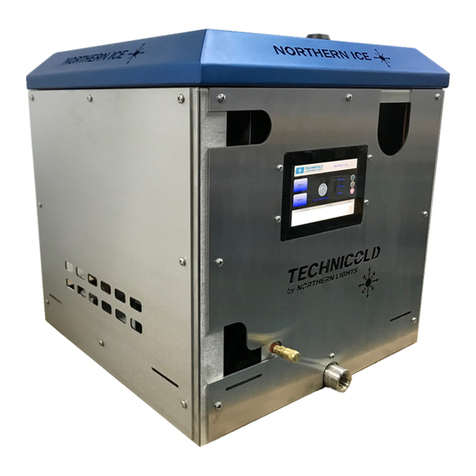
Northern Lights
Northern Lights TECHNICOLD OM-NI User manual

Northern Lights
Northern Lights NL673L4 User manual
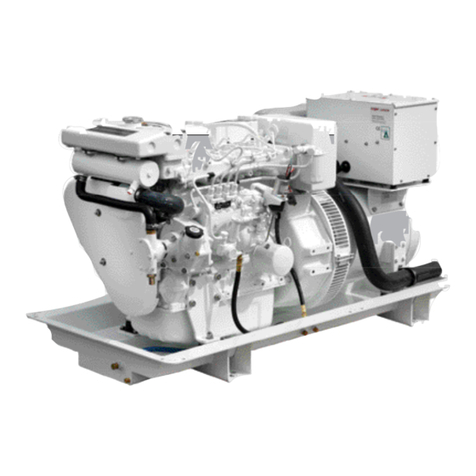
Northern Lights
Northern Lights OM944W3 User manual

Northern Lights
Northern Lights OL1276 User manual
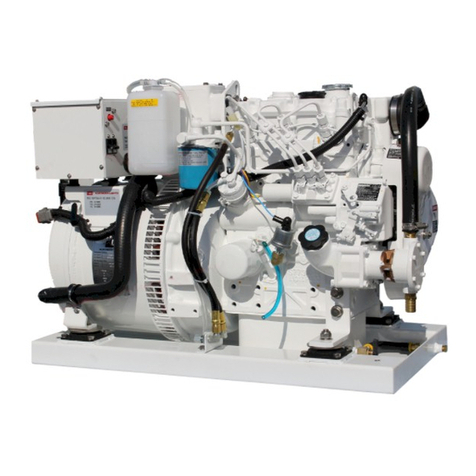
Northern Lights
Northern Lights Lugger M773LW3 User manual
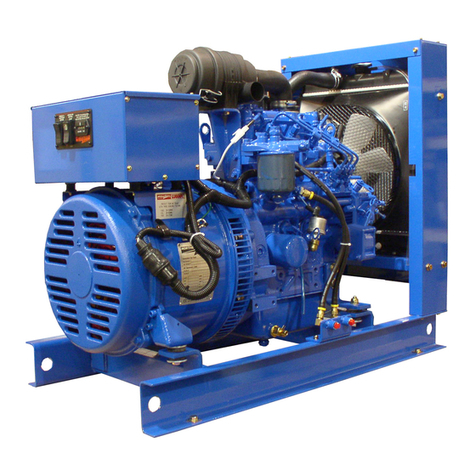
Northern Lights
Northern Lights NL773LW4 User manual

Northern Lights
Northern Lights OM844W3 User manual

Northern Lights
Northern Lights M944T User manual

